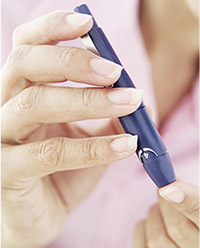Why is it important for people with diabetes to be physically active?
Physical activity can help you control your blood glucose, weight, and blood pressure, as well as raise your “good” cholesterol and lower your “bad” cholesterol. It can also help prevent heart and blood flow problems, reducing your risk of heart disease and nerve damage, which are often problems for people with diabetes.
How much and how often should people with diabetes exercise?
Experts recommend moderate-intensity physical activity for at least 30 minutes on 5 or more days of the week. Some examples of moderate-intensity physical activity are walking briskly, mowing the lawn, dancing, swimming, or bicycling.
If you are not accustomed to physical activity, you may want to start with a little exercise, and work your way up. As you become stronger, you can add a few extra minutes to your physical activity. Do some physical activity every day. It’s better to walk 10 or 20 minutes each day than one hour once a week.
Talk to your health care provider about a safe exercise plan. He or she may check your heart and your feet to be sure you have no special problems. If you have high blood pressure, eye, or foot problems, you may need to avoid some kinds of exercise.
For more information, see Controlling Your Diabetes from the Center for Disease Control and Prevention’s (CDC) publication, Take Charge of Your Diabetes.
What are some good types of physical activity for people with diabetes?
Walking vigorously, hiking, climbing stairs, swimming, aerobics, dancing, bicycling, skating, skiing, tennis, basketball, volleyball, or other sports are just some examples of physical activity that will work your large muscles, increase your heart rate, and make you breathe harder – important goals for fitness.
In addition, strength training exercises with hand weights, elastic bands, or weight machines can help you build muscle. Stretching helps to make you flexible and prevent soreness after other types of exercise.
Do physical activities you really like. The more fun you have, the more likely you will do it each day. It can be helpful to exercise with a family member or friend.
Are there any safety considerations for people with diabetes when they exercise?
Exercise is very important for people with diabetes to stay healthy, but there are a few things to watch out for.
You should avoid some kinds of physical activity if you have certain diabetes complications. Exercise involving heavy weights may be bad for people with blood pressure, blood vessel, or eye problems. Diabetes-related nerve damage can make it hard to tell if you’ve injured your feet during exercise, which can lead to more serious problems. If you do have diabetes complications, your health care provider can tell you which kinds of physical activity would be best for you. Fortunately, there are many different ways to get exercise.
Physical activity can lower your blood glucose too much, causing hypoglycemia, especially in people who take insulin or certain oral medications. Hypoglycemia can happen at the time you’re exercising, just afterward, or even up to a day later. You can get shaky, weak, confused, irritable, anxious, hungry, tired, or sweaty. You can get a headache, or even lose consciousness.
To help prevent hypoglycemia during physical activity, check your blood glucose before you exercise. If it’s below 100, have a small snack. In addition, bring food or glucose tablets with you when you exercise just in case. It is not good for people with diabetes to skip meals at all, but especially not prior to exercise. After you exercise, check to see how it has affected your blood glucose level. If you take insulin, ask your health care provider if there is a preferable time of day for you to exercise, or whether you should change your dosage before physical activity, before beginning an exercise regimen.
On the other hand, you should not exercise when your blood glucose is very high because your level could go even higher. Do not exercise if your blood glucose is above 300, or your fasting blood glucose is above 250 and you have ketones in your urine.
When you exercise, wear cotton socks and athletic shoes that fit well and are comfortable. After you exercise, check your feet for sores, blisters, irritation, cuts, or other injuries.
Drink plenty of fluids during physical activity, since your blood glucose can be affected by dehydration.




 And Other Power Foods >
And Other Power Foods >